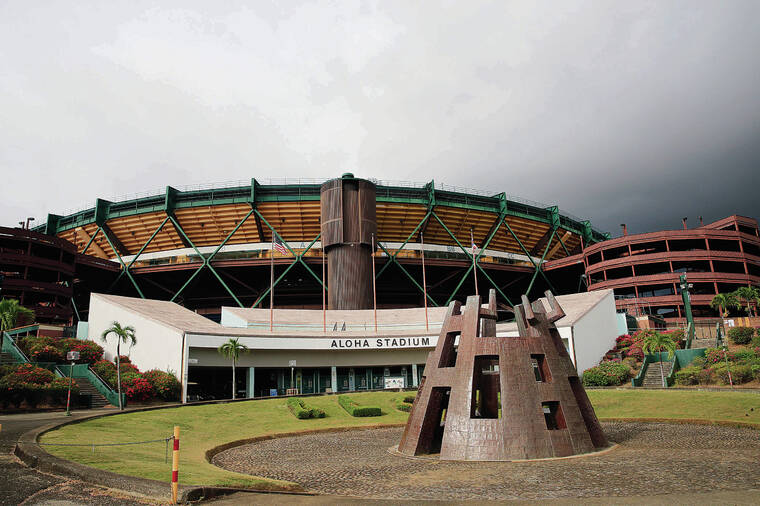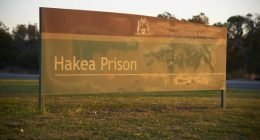
Mahalo for supporting Honolulu Star-Advertiser. Enjoy this free story!
Hawaii senators are pushing to shake up control of an effort in progress to replace Aloha Stadium and redevelop 73 acres of state land around a new facility in Halawa.
The Senate voted earlier this month to send the House a bill that would reassign a leading role among state agencies involved in two complex envisioned public-
private partnerships aiming to produce a new roughly $400 million stadium surrounded by housing, retail, restaurants, a hotel, offices and other uses on the 98-acre stadium property.
Senate Bill 3334, as unanimously approved by senators, aims to give the Hawaii Community Development Authority, a state agency primarily regulating development in Kakaako and Kalaeloa, sole jurisdiction over stadium lands.
Currently, this power is assigned to the Stadium Authority, an agency that manages the largely condemned 47-year-old Aloha Stadium and is working with the Department of Accounting and General Services to solicit and select private developers to turn the rusting 50,000-seat facility, along with its vast parking lot, into a new mixed-use community anchored by a new roughly 35,000-seat stadium.
The bill also would remove the Stadium Authority from its administrative attachment to DAGS and instead attach the authority to the same agency to which HCDA is attached: the Department of Business, Economic Development and Tourism.
The effort is rekindling what had been a prior struggle at the Legislature over which agency should have a dominant role in carrying out the redevelopment project referred to as the New Aloha Stadium Entertainment District.
Lawmakers in 2019 assigned this role to HCDA.
Then in 2020 an effort was made to place DAGS in charge of procuring competing bids from developers instead of HCDA, but it took until 2021 to make the change because of a few words in the 2020 bill that concerned some lawmakers over HCDA land lease power.
The difficulty two years ago set back a goal to issue a request for proposals to pick a developer that could deliver a new stadium in 2023. To date, that request has yet to be issued.
Prospective developers now are expressing concern about the latest proposed change involving HCDA.
HCDA’s new proposed role was added to SB 3334, which also proposes changes to the Hawaii Tourism Authority and the School Facilities Authority, in an amendment approved March 4 by a joint Senate Education and Ways and Means committee. The amended bill was then passed March 8 by the full Senate.
Sen. Glenn Wakai (D, Kalihi-Salt Lake), a Ways and Means member and NASED proponent, described the envisioned new role for HCDA at the March 4 hearing as something intended to more efficiently advance the project.
“We really want to make it a creative process that allows for the successful and timely development of the area,” he said. “So we’re going to add a part that helps do that. And we’re going to do that by establishing the stadium area as a new HCDA development district. And with that structure we get all the empowerments — the entitlements, I should say — and all the powers of HCDA to help with the facilitation of the development of that area.”
Wakai also said that the change made in 2021 included a conceptual agreement for HCDA to assist DAGS and the Stadium Authority that hasn’t produced intended results.
HCDA interim Executive Director Craig Nakamoto told lawmakers at two hearings Friday that prospective NASED developers have expressed concern about another layer of governance being inserted into the project.
“Developers may be getting sort of worried that there’s another level of bureaucracy or another level of jurisdiction in place — Stadium Authority, maybe DAGS is there, too, and then you have HCDA,” he said, adding that some developers are skittish or anxious about the proposed change.
According to Nakamoto, a main thrust of what senators want from HCDA, though it isn’t clear in the bill, is to have the agency use its zoning power to establish new development rules for the stadium site.
Currently, the land is subject to city transit-oriented development zoning, and developers are expected to craft their bids for redeveloping land around a new stadium based on what this zoning allows.
Nakamoto said it could take HCDA two years to adopt zoning rules for the stadium area, and he suggested that giving HCDA control over development rules for the stadium site could be enacted in 2025 and apply to phases of redevelopment after that.
DAGS is in the middle of procuring a developer for land around a new stadium site.
The agency announced Jan. 31 the selection of two developer-led teams as finalists for this job after publishing a request for competing proposals in October. A winning detailed bid is expected to be picked by summer, followed by construction starting in 2023 on an initial phase of mixed-use development, with future phases that could take around two decades or longer to complete.
Replacing the stadium is a separate deal in which three development teams were approved as qualified to bid in December 2020. Asking those three teams to submit bids was scheduled for Dec. 15 but postponed because more work and approvals were needed. This request to bid is expected to be made in the next couple of weeks.
The stadium replacement project would have a developer design, build and maintain a new stadium to be operated by the Stadium Authority.
State lawmakers initially approved $350 million in state taxpayer financing to help pay for the new stadium and possibly some surrounding real estate project infrastructure. This appropriation got cut by lawmakers to $170 million in 2021.
Now lawmakers are considering restoring the $350 million appropriation, but such funding could be caught up between what senators and House members want as to whether HCDA should be given regulatory authority over the stadium site.
On Friday the House Committee on Economic Development voted 8-0 to strike language in SB 3334 having to do with HCDA’s proposed new role in NASED. The bill includes $350 million in funding for the project.
House members intend to provide a $350 million appropriation for NASED in the state’s budget bill.
If SB 3334 is ultimately approved by a majority of House members in a different form from the last Senate draft, differences would have to be reconciled by House and Senate leaders to be enacted.
Curt Otaguro, who heads DAGS as comptroller, told key committees in the House and Senate on Friday that there is still an opportunity to do the project right.
“We are at a crossroads,” he said.
Source: Star Ads




